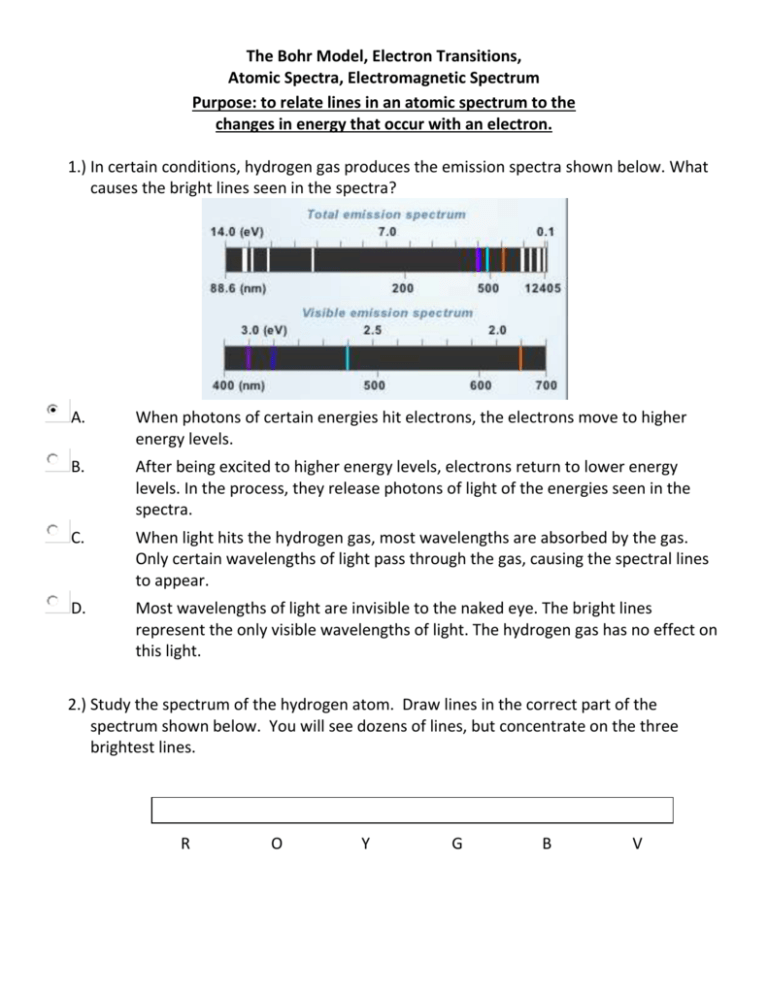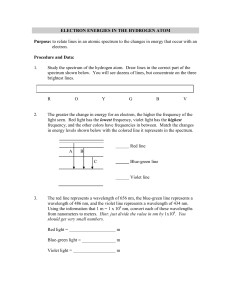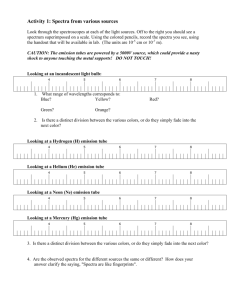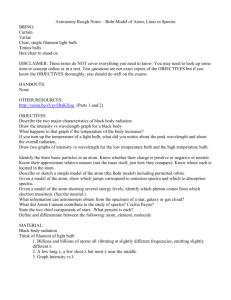Atomic Spectra, Electromagnetic Spectrum
advertisement

The Bohr Model, Electron Transitions, Atomic Spectra, Electromagnetic Spectrum Purpose: to relate lines in an atomic spectrum to the changes in energy that occur with an electron. 1.) In certain conditions, hydrogen gas produces the emission spectra shown below. What causes the bright lines seen in the spectra? A. When photons of certain energies hit electrons, the electrons move to higher energy levels. B. After being excited to higher energy levels, electrons return to lower energy levels. In the process, they release photons of light of the energies seen in the spectra. C. When light hits the hydrogen gas, most wavelengths are absorbed by the gas. Only certain wavelengths of light pass through the gas, causing the spectral lines to appear. D. Most wavelengths of light are invisible to the naked eye. The bright lines represent the only visible wavelengths of light. The hydrogen gas has no effect on this light. 2.) Study the spectrum of the hydrogen atom. Draw lines in the correct part of the spectrum shown below. You will see dozens of lines, but concentrate on the three brightest lines. R O Y G B V 3.) The greater the change in energy for an electron, the higher the frequency of the light seen. Red light has the lowest frequency, violet light has the highest frequency, and the other colors have frequencies in between. Match the changes in energy levels shown below with the colored line it represents in the spectrum. Red line A B C Blue-green line Violet line 4.) The red line represents a wavelength of 656 nm, the blue-green line represents a wavelength of 486 nm, and the violet line represents a wavelength of 434 nm. Using the information that 1 m = 1 x 109 nm, convert each of these wavelengths from nanometers to meters. Hint: just divide the value in nm by 1x109. You should get very small numbers. Red light = m Blue-green light = m Violet light = m 5.) Calculate the frequency of each color of light using this equation: Frequency = speed of light (3 x 108 m) wavelength Frequency of red light Hz Frequency of blue-green light Hz Frequency of violet light Hz 6.) Calculate the energy of each color of light using the equation E = h, where h = Planck’s constant (6.626 x 10-34 J s) and is the frequency of the light. Energy of red light J Energy of blue-green light J Energy of violet light J 7.) Notice the energy change for an electron moving in two energy levels (from energy level 4 to energy level 2) compared to the energy change for an electron moving in only one energy level (from energy level 3 to energy level 1). Why doesn’t the electron lose twice as much energy when it moves in two levels as it loses when it moves only one energy level? Hint: look at the diagram of energy levels. 8.) Is the relationship between energy and frequency a direct or an inverse relationship? 9.) Which frequency of light has the most energy? A. red B. yellow C. green D. violet Refer to the Bohr model of the hydrogen atom in the chemistry state reference tables. 10.) A. What color of light is emitted when an electron moves from the third energy level to the second energy level? red B. yellow C. blue-green D. violet 11.) A. B. Which electron transition would result in emission of ultraviolet radiation? Level 4 to level 1 C. Level 5 to level 2 Level 4 to level 3 D. Level 3 to level 2 12.) A. B. C. D. In what way do atomic spectra support the Bohr model of the atom? The spectra indicate that electrons have practically no mass. The spectra make it possible to calculate the charge on the electron. The spectra indicate that the nucleus is very small compared to the atom. The spectra contain only certain frequencies of light rather than being continuous.










